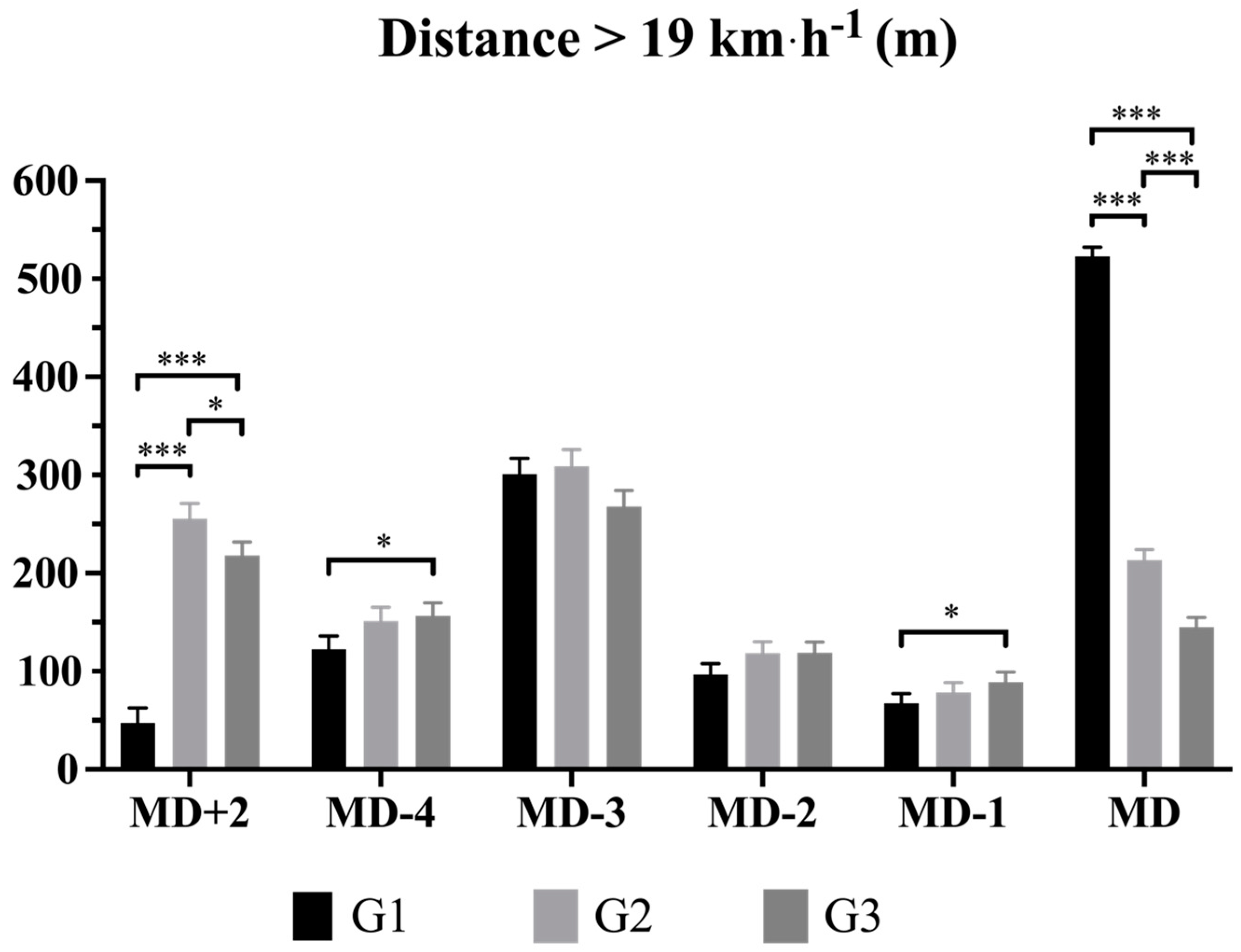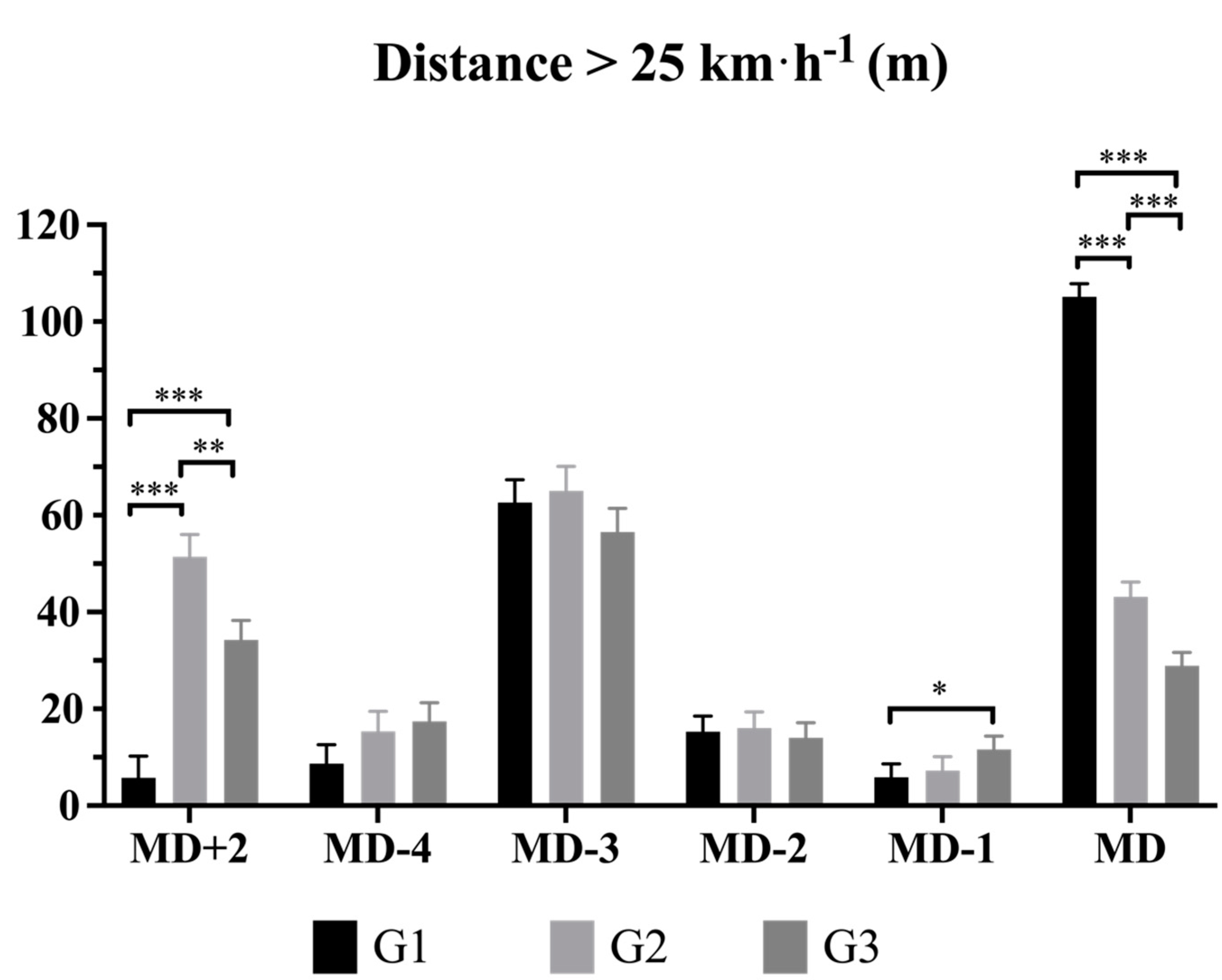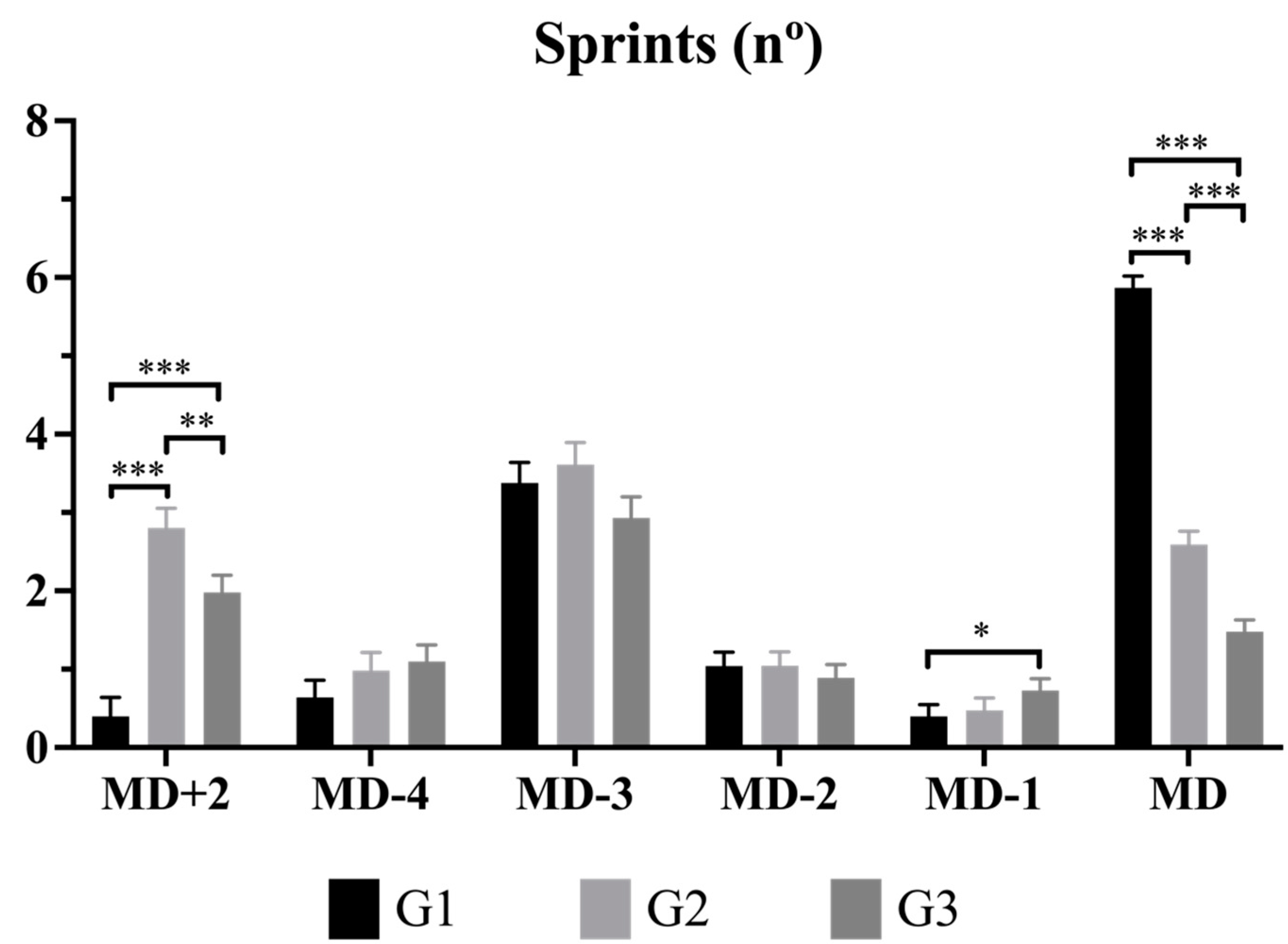Holistic Workload Quantification within a Professional Soccer Microcycle Considering Players’ Match Participation
Abstract
1. Introduction
2. Materials and Methods
2.1. Participants
2.2. Study Design and Procedures
2.3. Instruments and Variables
2.4. Statistical Analysis
3. Results
3.1. Internal and Mental Load
3.2. External Load
4. Discussion
5. Conclusions
Author Contributions
Funding
Institutional Review Board Statement
Informed Consent Statement
Data Availability Statement
Conflicts of Interest
References
- Ade, J.; Fitzpatrick, J.; Bradley, P.S. High-Intensity Efforts in Elite Soccer Matches and Associated Movement Patterns, Technical Skills and Tactical Actions. Information for Position-Specific Training Drills. J. Sports Sci. 2016, 34, 2205–2214. [Google Scholar] [CrossRef]
- Pons, E.; Ponce-Bordón, J.C.; Díaz-García, J.; Del Campo, R.L.; Resta, R.; Peirau, X.; García-Calvo, T. A Longitudinal Exploration of Match Running Performance during a Football Match in the Spanish La Liga: A Four-Season Study. Int. J. Environ. Res. Public Health 2021, 18, 1133. [Google Scholar] [CrossRef] [PubMed]
- Lago-Peñas, C.; Lorenzo-Martinez, M.; López-Del Campo, R.; Resta, R.; Rey, E. Evolution of Physical and Technical Parameters in the Spanish LaLiga 2012–2019. Sci. Med. Footb. 2023, 7, 41–46. [Google Scholar] [CrossRef]
- Allen, T.; Taberner, M.; Zhilkin, M.; Rhodes, D. Running More than before? The Evolution of Running Load Demands in the English Premier League. Int. J. Sports Sci. Coach. 2023, 19, 779–787. [Google Scholar] [CrossRef]
- Oliva-Lozano, J.M.; Fortes, V.; Muyor, J.M. When and How Do Elite Soccer Players Sprint in Match Play? A Longitudinal Study in a Professional Soccer League. Res. Sports Med. 2023, 31, 1–12. [Google Scholar] [CrossRef]
- Beato, M.; Drust, B.; Iacono, A. Dello Implementing High-Speed Running and Sprinting Training in Professional Soccer. Int. J. Sports Med. 2021, 42, 295–299. [Google Scholar] [CrossRef]
- Gualtieri, A.; Rampinini, E.; Sassi, R.; Beato, M. Workload Monitoring in Top-Level Soccer Players During Congested Fixture Periods. Int. J. Sports Med. 2020, 41, 677–681. [Google Scholar] [CrossRef] [PubMed]
- Vieira, L.H.P.; Aquino, R.; Lago-Peñas, C.; Martins, G.H.M.; Puggina, E.F.; Barbieri, F.A. Running Performance in Brazilian Professional Football Players during a Congested Match Schedule. J. Strength Cond. Res. 2018, 32, 313–325. [Google Scholar] [CrossRef]
- Carling, C.; Gregson, W.; McCall, A.; Moreira, A.; Wong, D.P.; Bradley, P.S. Match Running Performance during Fixture Congestion in Elite Soccer: Research Issues and Future Directions. Sports Med. 2015, 45, 605–613. [Google Scholar] [CrossRef]
- Oliveira, R.; Brito, J.; Martins, A.; Mendes, B.; Calvete, F.; Carriço, S.; Ferraz, R.; Marques, M.C. In-Season Training Load Quantification of One-, Two- and Three-Game Week Schedules in a Top European Professional Soccer Team. Physiol. Behav. 2019, 201, 146–156. [Google Scholar] [CrossRef]
- Martín-García, A.; Gómez Díaz, A.; Bradley, P.S.; Morera, F.; Casamichana, D. Quantification of a Professional Football Team’s External Load Using a Microcycle Structure. J. Strength Cond. Res. 2018, 32, 3511–3518. [Google Scholar] [CrossRef] [PubMed]
- Silva, H.; Nakamura, F.Y.; Castellano, J.; Marcelino, R. Training Load within a Soccer Microcycle Week—A Systematic Review. Strength Cond. J. 2023, 45, 568–577. [Google Scholar] [CrossRef]
- Buchheit, M.; Lacome, M.; Cholley, Y.; Simpson, B.M. Neuromuscular Responses to Conditioned Soccer Sessions Assessed via GPS-Embedded Accelerometers: Insights into Tactical Periodization. Int. J. Sports Physiol. Perform. 2017, 13, 577–583. [Google Scholar] [CrossRef] [PubMed]
- Castillo, D.; Raya-González, J.; Weston, M.; Yanci, J. Distribution of External Load During Acquisition Training Sessions and Match Play of a Professional Soccer Team. J. Strength Cond. Res. 2021, 35, 3453–3458. [Google Scholar] [CrossRef] [PubMed]
- Teixeira, J.E.; Branquinho, L.; Ferraz, R.; Leal, M.; Silva, A.J.; Barbosa, T.M.; Monteiro, A.M.; Forte, P. Weekly Training Load across a Standard Microcycle in a Sub-Elite Youth Football Academy: A Comparison between Starters and Non-Starters. Int. J. Environ. Res. Public Health 2022, 19, 1611. [Google Scholar] [CrossRef] [PubMed]
- Nobari, H.; Alijanpour, N.; Martins, A.D.; Oliveira, R. Acute and Chronic Workload Ratios of Perceived Exertion, Global Positioning System, and Running-Based Variables Between Starters and Non-Starters: A Male Professional Team Study. Front. Psychol. 2022, 13, 860888. [Google Scholar] [CrossRef] [PubMed]
- Oliveira, R.; Canário-Lemos, R.; Morgans, R.; Rafael-Moreira, T.; Vilaça-Alves, J.; Brito, J.P. Are Non-Starters Accumulating Enough Load Compared with Starters? Examining Load, Wellness, and Training/Match Ratios of a European Professional Soccer Team. BMC Sports Sci. Med. Rehabil. 2023, 15, 129. [Google Scholar] [CrossRef] [PubMed]
- Díaz-Serradilla, E.; Castillo, D.; Rodríguez-Marroyo, J.A.; Raya González, J.; Villa Vicente, J.G.; Rodríguez-Fernández, A. Effect of Different Nonstarter Compensatory Strategies on Training Load in Female Soccer Players: A Pilot Study. Sports Health 2023, 15, 835–841. [Google Scholar] [CrossRef] [PubMed]
- Díaz-García, J.; González-Ponce, I.; Ponce-Bordón, J.C.; López-Gajardo, M.; García-Calvo, T. Diseño y Validación Del Cuestionario Para Valorar La Carga Mental En Los Deportes de Equipo (CCMDE). Cuad. Psicol. Deporte 2021, 21, 138–145. [Google Scholar] [CrossRef]
- García-Calvo, T.; Pulido, J.J.; Ponce-Bordón, J.C.; López-Gajardo, M.Á.; Costa, I.T.; Díaz-García, J. Can Rules in Technical-Tactical Decisions Influence on Physical and Mental Load during Soccer Training? A Pilot Study. Int. J. Environ. Res. Public Health 2021, 18, 4313. [Google Scholar] [CrossRef]
- Díaz-García, J.; Pulido, J.J.; Ponce-Bordón, J.C.; Cano-Prado, C.; López-Gajardo, M.Á.; García-Calvo, T. Coach Encouragement During Soccer Practices Can Influence Players’ Mental and Physical Loads. J. Hum. Kinet. 2021, 79, 277–288. [Google Scholar] [CrossRef] [PubMed]
- Badin, O.O.; Smith, M.R.; Conte, D.; Coutts, A.J. Mental Fatigue: Impairment of Technical Performance in Small-Sided Soccer Games. Int. J. Sports Physiol. Perform. 2016, 11, 1100–1105. [Google Scholar] [CrossRef]
- Smith, M.R.; Coutts, A.J.; Merlini, M.; Deprez, D.; Lenoir, M.; Marcora, S.M. Mental Fatigue Impairs Soccer-Specific Physical and Technical Performance. Med. Sci. Sports Exerc. 2016, 48, 267–276. [Google Scholar] [CrossRef]
- Smith, M.R.; Thompson, C.; Marcora, S.M.; Skorski, S.; Meyer, T.; Coutts, A.J. Mental Fatigue and Soccer: Current Knowledge and Future Directions. Sports Med. 2018, 48, 1525–1532. [Google Scholar] [CrossRef]
- Castillo, D.; Yanci, J.; Cámara, J.; Weston, M. The Influence of Soccer Match Play on Physiological and Physical Performance Measures in Soccer Referees and Assistant Referees. J. Sports Sci. 2016, 34, 557–563. [Google Scholar] [CrossRef] [PubMed]
- R-Studio Team. RStudio: Integrated Development for R; RStudio: Boston, MA, USA, 2020. [Google Scholar]
- Heck, R.H.; Thomas, S.L. An Introduction to Multilevel Modeling Techniques: MLM and SEM Approaches; Routledge: New York, NY, USA, 2020. [Google Scholar]
- Los Arcos, A.; Mendez-Villanueva, A.; Martínez-Santos, R. In-Season Training Periodization of Professional Soccer Players. Biol. Sport 2017, 34, 149–155. [Google Scholar] [CrossRef] [PubMed]
- Los Arcos, A.; Méndez-Villanueva, A.; Yanci, J.; Martínez-Santos, R. Respiratory and Muscular Perceived Exertion during Official Games in Professional Soccer Players. Int. J. Sports Physiol. Perform. 2016, 11, 301–304. [Google Scholar] [CrossRef]
- Van Cutsem, J.; Marcora, S.; De Pauw, K.; Bailey, S.; Meeusen, R.; Roelands, B. The Effects of Mental Fatigue on Physical Performance: A Systematic Review. Sports Med. 2017, 47, 1569–1588. [Google Scholar] [CrossRef]
- Faude, O.; Koch, T.; Meyer, T. Straight Sprinting Is the Most Frequent Action in Goal Situations in Professional Football. J. Sports Sci. 2012, 30, 625–631. [Google Scholar] [CrossRef]
- Filter, A.; Olivares-Jabalera, J.; Dos’Santos, T.; Madruga, M.; Lozano, J.; Molina, A.; Santalla, A.; Requena, B.; Loturco, I. High-Intensity Actions in Elite Soccer: Current Status and Future Perspectives. Int. J. Sports Med. 2023, 44, 535–544. [Google Scholar] [CrossRef]
- Castillo, D.; Raya-González, J.; Manuel Clemente, F.; Yanci, J. The Influence of Youth Soccer Players’ Sprint Performance on the Different Sided Games’ External Load Using GPS Devices. Res. Sports Med. 2020, 28, 194–205. [Google Scholar] [CrossRef] [PubMed]
- Dalen, T.; Jorgen, I.; Gertjan, E.; Havard, H.; Ulrik, W. Player Load, Acceleration and Deceleration during Forty-Five Competitive Matches of Elite Soccer. J. Strength Cond. Res. 2016, 30, 351–359. [Google Scholar] [CrossRef] [PubMed]
- Buchheit, M.; Al Haddad, H.; Simpson, B.M.; Palazzi, D.; Bourdon, P.C.; Di Salvo, V.; Mendez-Villanueva, A. Monitoring Accelerations with Gps in Football: Time to Slow Down. Int. J. Sports Physiol. Perform. 2014, 9, 442–445. [Google Scholar] [CrossRef] [PubMed]
- Soler, A.; Agullo, F.; Hernández-Davó, J.L.; Raya-González, J.; del Coso, J.; Gonzalez-Rodenas, J.; Moreno-Pérez, V. Influence of the External Workload on Calf Muscle Strain Injuries in Professional Football Players: A Pilot Study. Sports Health Multidiscip. J. 2024. ahead of print. [Google Scholar] [CrossRef]
- García-Calvo, T.; Ponce-Bordón, J.C.; Pons, E.; del Campo, R.L.; Resta, R.; Raya-González, J. High Metabolic Load Distance in Professional Soccer According to Competitive Level and Playing Positions. PeerJ 2022, 10, e13318. [Google Scholar] [CrossRef]




| MD+2 | MD-4 | MD-3 | MD-2 | MD-1 | MD | ||||||||
|---|---|---|---|---|---|---|---|---|---|---|---|---|---|
| Coeff (SE) | p | Coeff (SE) | p | Coeff (SE) | p | Coeff (SE) | p | Coeff (SE) | p | Coeff (SE) | p | ||
| RPE | G1 | 3.94 (0.11) | a ***, b *** | 6.35 (0.10) | 6.27 (0.12) | c ** | 4.42 (0.08) | a ***, b *** | 3.90 (0.06) | a **, b ***, c *** | 8.46 (0.06) | a ***, b ***, c *** | |
| G2 | 6.28 (0.12) | 6.48 (0.10) | 6.57 (0.13) | 5.16 (0.08) | 4.09 (0.07) | 6.29 (0.07) | |||||||
| G3 | 6.11 (0.10) | 6.35 (0.10) | 6.10 (0.12) | 5.15 (0.07) | 4.42 (0.06) | 5.05 (0.06) | |||||||
| Cognitive load | G1 | 3.90 (0.13) | a ***, b *** | 6.06 (0.11) | 6.04 (0.14) | 4.48 (0.08) | a ***, b *** | 4.05 (0.07) | b ***, c *** | 7.91 (0.07) | a ***, b ***, c *** | ||
| G2 | 5.96 (0.13) | 6.09 (0.12) | 6.22 (0.15) | 5.13 (0.09) | 4.18 (0.07) | 6.79 (0.08) | |||||||
| G3 | 5.89 (0.11) | 6.33 (0.11) | 6.14 (0.14) | 5.33 (0.08) | 4.74 (0.07) | 5.93 (0.07) | |||||||
| Emotional load | G1 | 3.90 (0.12) | a ***, b *** | 6.05 (0.10) | 6.06 (0.13) | 4.50 (0.08) | a ***, b ***, c * | 4.03 (0.07) | a *, b ***, c *** | 7.84 (0.06) | a ***, b ***, c *** | ||
| G2 | 6.01 (0.13) | 6.25 (0.11) | 6.32 (0.14) | 5.10 (0.09) | 4.23 (0.07) | 6.76 (0.07) | |||||||
| G3 | 5.97 (0.11) | 6.26 (0.10) | 6.03 (0.14) | 5.34 (0.08) | 4.75 (0.07) | 5.91 (0.06) | |||||||
| Affective load | G1 | 3.82 (0.12) | a ***, b *** | 6.08 (0.11) | 6.16 (0.13) | 4.52 (0.08) | a ***, b *** | 4.05 (0.07) | b ***, c *** | 7.92 (0.07) | a ***, b ***, c *** | ||
| G2 | 5.98 (0.13) | 6.23 (0.11) | 6.39 (0.14) | 5.12 (0.09) | 4.20 (0.07) | 6.81 (0.08) | |||||||
| G3 | 5.90 (0.11) | 6.22 (0.11) | 6.10 (0.14) | 5.32 (0.08) | 4.70 (0.07) | 5.94 (0.07) | |||||||
| Motivation | G1 | 6.22 (0.17) | b * | 6.83 (0.14) | b **, c * | 6.52 (0.18) | 6.47 (0.11) | 6.28 (0.08) | b * | 8.15 (0.08) | a ***, b ***, c *** | ||
| G2 | 6.60 (0.18) | 6.90 (0.15) | 6.80 (0.20) | 6.49 (0.11) | 6.41 (0.09) | 7.23 (0.10) | |||||||
| G3 | 6.78 (0.15) | 7.41 (0.14) | 6.87 (0.19) | 6.65 (0.10) | 6.55 (0.08) | 6.69 (0.08) | |||||||
| Mental Fatigue | G1 | 3.91 (0.13) | a ***, b *** | 4.80 (0.11) | a * | 4.89 (0.14) | 4.29 (0.08) | b ** | 3.66 (0.06) | b * | 7.52 (0.06) | a ***, b ***, c *** | |
| G2 | 4.86 (0.13) | 5.19 (0.12) | 4.96 (0.15) | 4.44 (0.09) | 3.73 (0.07) | 6.08 (0.08) | |||||||
| G3 | 4.67 (0.11) | 5.07 (0.11) | 4.92 (0.14) | 4.60 (0.08) | 3.85 (0.07) | 5.20 (0.06) | |||||||
| MD+2 | MD-4 | MD-3 | MD-2 | MD-1 | MD | ||||||||
|---|---|---|---|---|---|---|---|---|---|---|---|---|---|
| Coeff (SE) | p | Coeff (SE) | p | Coeff (SE) | p | Coeff (SE) | p | Coeff (SE) | p | Coeff (SE) | p | ||
| ACC (nº) | G1 | 6.84 (0.95) | a ***, b *** | 24.38 (0.85) | 19.36 (1.01) | b * | 12.13 (0.71) | a ***, b ** | 12.35 (0.62) | 26.61 (0.61) | a ***, b ***, c * | ||
| G2 | 18.11 (0.98) | 24.44 (0.90) | 19.05 (1.08) | 14.86 (0.74) | 13.09 (0.65) | 14.41 (0.67) | |||||||
| G3 | 20.15 (0.87) | 22.93 (0.84) | 16.71 (1.05) | 14.09 (0.693) | 13.21 (0.62) | 15.93 (0.61) | |||||||
| DEC (nº) | G1 | 5.27 (0.94) | a ***, b *** | 20.11 (0.84) | 18.45 (0.99) | b ***, c ** | 9.77 (0.73) | a ***, b *** | 9.45 (0.65) | a ** | 32.28 (0.64) | a ***, b ***, c *** | |
| G2 | 19.05 (0.96) | 20.23 (0.88) | 18.19 (1.04) | 12.81 (0.75) | 10.94 (0.67) | 13.78 (0.69) | |||||||
| G3 | 18.90 (0.86) | 18.50 (0.84) | 14.33 (1.02) | 12.26 (0.71) | 10.18 (0.65) | 11.42 (0.65) | |||||||
| PLoad (m) | G1 | 310 (18.1) | a ***, b ***, c * | 464 (16.1) | 561 (19.2) | 409 (13.6) | a ***, b *** | 374 (12.0) | a **, b ** | 892 (11.7) | a ***, b *** | ||
| G2 | 587 (18.6) | 474 (17.0) | 554 (20.4) | 471 (14.1) | 411 (12.4) | 395 (12.8) | |||||||
| G3 | 545 (16.5) | 467 (16.0) | 529 (19.8) | 473 (13.1) | 415 (11.9) | 402 (11.8) | |||||||
Disclaimer/Publisher’s Note: The statements, opinions and data contained in all publications are solely those of the individual author(s) and contributor(s) and not of MDPI and/or the editor(s). MDPI and/or the editor(s) disclaim responsibility for any injury to people or property resulting from any ideas, methods, instructions or products referred to in the content. |
© 2024 by the authors. Licensee MDPI, Basel, Switzerland. This article is an open access article distributed under the terms and conditions of the Creative Commons Attribution (CC BY) license (https://creativecommons.org/licenses/by/4.0/).
Share and Cite
dos Santos Guimarães, R.; García-Calvo, T.; Lobo-Triviño, D.; Ponce-Bordón, J.C.; Raya-González, J. Holistic Workload Quantification within a Professional Soccer Microcycle Considering Players’ Match Participation. Appl. Sci. 2024, 14, 5139. https://doi.org/10.3390/app14125139
dos Santos Guimarães R, García-Calvo T, Lobo-Triviño D, Ponce-Bordón JC, Raya-González J. Holistic Workload Quantification within a Professional Soccer Microcycle Considering Players’ Match Participation. Applied Sciences. 2024; 14(12):5139. https://doi.org/10.3390/app14125139
Chicago/Turabian Styledos Santos Guimarães, Rodrigo, Tomás García-Calvo, David Lobo-Triviño, José C. Ponce-Bordón, and Javier Raya-González. 2024. "Holistic Workload Quantification within a Professional Soccer Microcycle Considering Players’ Match Participation" Applied Sciences 14, no. 12: 5139. https://doi.org/10.3390/app14125139
APA Styledos Santos Guimarães, R., García-Calvo, T., Lobo-Triviño, D., Ponce-Bordón, J. C., & Raya-González, J. (2024). Holistic Workload Quantification within a Professional Soccer Microcycle Considering Players’ Match Participation. Applied Sciences, 14(12), 5139. https://doi.org/10.3390/app14125139









